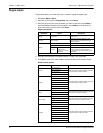
72 © 2014 Schneider Electric All Rights Reserved
Chapter 10—Verifying accuracy PowerLogic™ PM5100 series user guide
temperature before calibration to help ensure that the meters will reach their optimal
accuracy at operating temperature.
Most high precision electronic equipment requires a warm up time before it reaches its
specified performance levels. Energy meter standards allow the manufacturers to
specify meter accuracy derating due to ambient temperature changes and self-heating.
Your meter complies with and meets the requirements of these energy metering
standards.
For a list of accuracy standards that your meter complies to, contact your local
Schneider Electric representative or download the meter brochure from
www.schneider-electric.com.
Reference device or energy standard
To help ensure the accuracy of the test, it is recommended that you use a reference
device or reference energy standard with a specified accuracy that is 6 to 10 times
more accurate than the meter under test. Before you start testing, the reference device
or energy standard should be warmed up as recommended by its manufacturer.
NOTE: Verify the accuracy and precision of all measurement equipment used in
accuracy testing (for example, voltmeters, ammeters, power factor meters).
Energy pulsing
You can configure the meter’s alarm /energy LED or one of the digital outputs for
energy pulsing.
• The meter is equipped with an alarm / energy pulsing LED. When configured for
energy pulsing, the LED emits pulses that are then used to determine the accuracy
of the meter’s energy measurements.
• The meter is equipped with a digital output. When you configure the digital output
for energy pulsing, the meter sends voltage pulses to the digital output port, which
are then used to determine the accuracy of the meter’s energy measurements.
Location of energy pulsing LED
PM5100
Alarm / energy pulsing LED


















